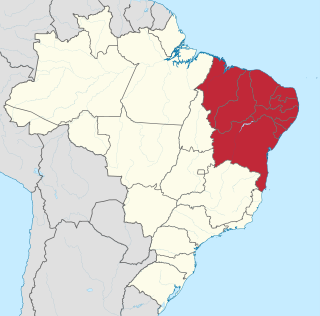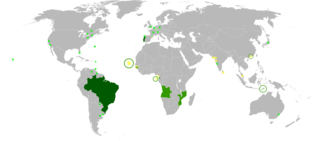
Tocantins is one of the states of Brazil.. It is the newest of the 26 Brazilian states, formed in 1988 and encompassing what had formerly been the northern two-fifths of the state of Goiás. Tocantins covers 277,620.91 square kilometres (107,190.03 sq mi) and has a population of 1,496,880. Construction of its capital, Palmas, began in 1989; most of the other cities in the state date to the Portuguese colonial period. With the exception of Araguaína there are few other cities with a significant population in the state. The government has invested in a new capital, a major hydropower dam, railroads and related infrastructure to develop this primarily agricultural area.
The Awá, or Guajá, are an indigenous people of Brazil living in the eastern Amazon rainforest. There are approximately 350 members, and 100 of them have no contact with the outside world. They are considered highly endangered because of conflicts with logging interests in their territory.

The Tumucumaque Mountains National Park is situated in the Amazon Rainforest in the Brazilian states of Amapá and Pará. It is bordered to the north by French Guiana and Suriname.

Mato Grosso is one of the states of Brazil, the third-largest by area, located in the western part of the country.

Porto Seguro is a city located in the far south of Bahia, Brazil. The city has an estimated population of 145,431 (2015), covers 2,287 square kilometres (883 sq mi), and has a population density of 52.7 residents per square kilometer. The area that includes Porto Seguro and neighboring Santa Cruz Cabrália and Prado holds a distinctive place in Brazilian history: in 1500 it was the first landing point of Portuguese navigators, principally Pedro Álvares Cabral. The crime rate is considered high, as is the case in all Bahia State
A wildlife refuge, also known as a wildlife sanctuary, is a naturally occurring sanctuary, such as an island, that provides protection for wildlife species from hunting, predation, competition or poaching; it is a protected area, a geographic territory within which wildlife is protected. Refuges can preserve animals that are endangered.

Mogi Guaçu is a municipality in the state of São Paulo in Brazil. The population is 147,233 in an area of 813 km². The city is at an average elevation of 591 m. Mogi Guaçu is a place name that probably originates from the Tupi language. It means "large river of snakes". The city was founded on April 9, 1877.

The Northeast Region of Brazil is one of the five official and political regions of the country according to the Brazilian Institute of Geography and Statistics. For the socio-geographic area see Nordeste. Of Brazil's twenty-six states, it comprises nine: Maranhão, Piauí, Ceará, Rio Grande do Norte, Paraíba, Pernambuco, Alagoas, Sergipe and Bahia, along with the Fernando de Noronha archipelago.

A natural monument is a natural or natural/cultural feature of outstanding or unique value because of its inherent rarity, representative of aesthetic qualities or cultural significance.

Águas Mornas is a Brazilian municipality in the state of Santa Catarina.

Abelardo Luz is a Brazilian municipality in the state of Santa Catarina. Until 1958 it was part of the municipality of Xanxerê. It is the birthplace of Brazilian former football player Paulo Roberto Falcão.

The environment of Brazil is characterized by high biodiversity with a population density that decreases away from the coast.
Even though progress has been made in conserving Brazil’s landscapes, the country still faces serious threats due to its historica land use. Amazonian forests substantially influence regional and global climates and deforesting this region is both a regional and global driver of climate change due to the high amounts of deforestation and habitat fragmentation that have occurred this region.

An environmental protection area is a type of protected area in Brazil that has some degree of human occupation, but where the primary intent is environmental protection. Human occupation is monitored and controlled. An environmental protection area often contains other types of conservation units, which may be more strictly protected.

National Parks are a legally-defined type of protected area of Brazil. The first parks were created in the 1930s, and other parks were gradually added, typically protecting a natural monument such as a waterfall or gorge near to a coastal population centre. At least two early parks were later submerged by hydroelectric reservoirs. The first park in the Amazon rainforest was inaugurated in 1974. Today the national parks cover a huge area, particularly in the Amazon. However, many of them suffer from outstanding claims for compensation from former owners or users of the land, and many lack the management plans, physical infrastructure and personnel needed to support public visits. The responsible government agency does not have the capacity to provide services such as food and drink, souvenir sales and guided tours, and bureaucracy has delayed letting the private sector bid on providing such services.

A state park in Brazil is a legally defined type of protected area operated by one of the states. Their goal is to preserve important or beautiful natural ecosystems. Public access is allowed subject to regulations defined by the responsible agency.

The Amazon Region Protected Areas Program is a joint initiative sponsored by government and non-government agencies to expand protection of the Amazon rainforest in Brazil.
















